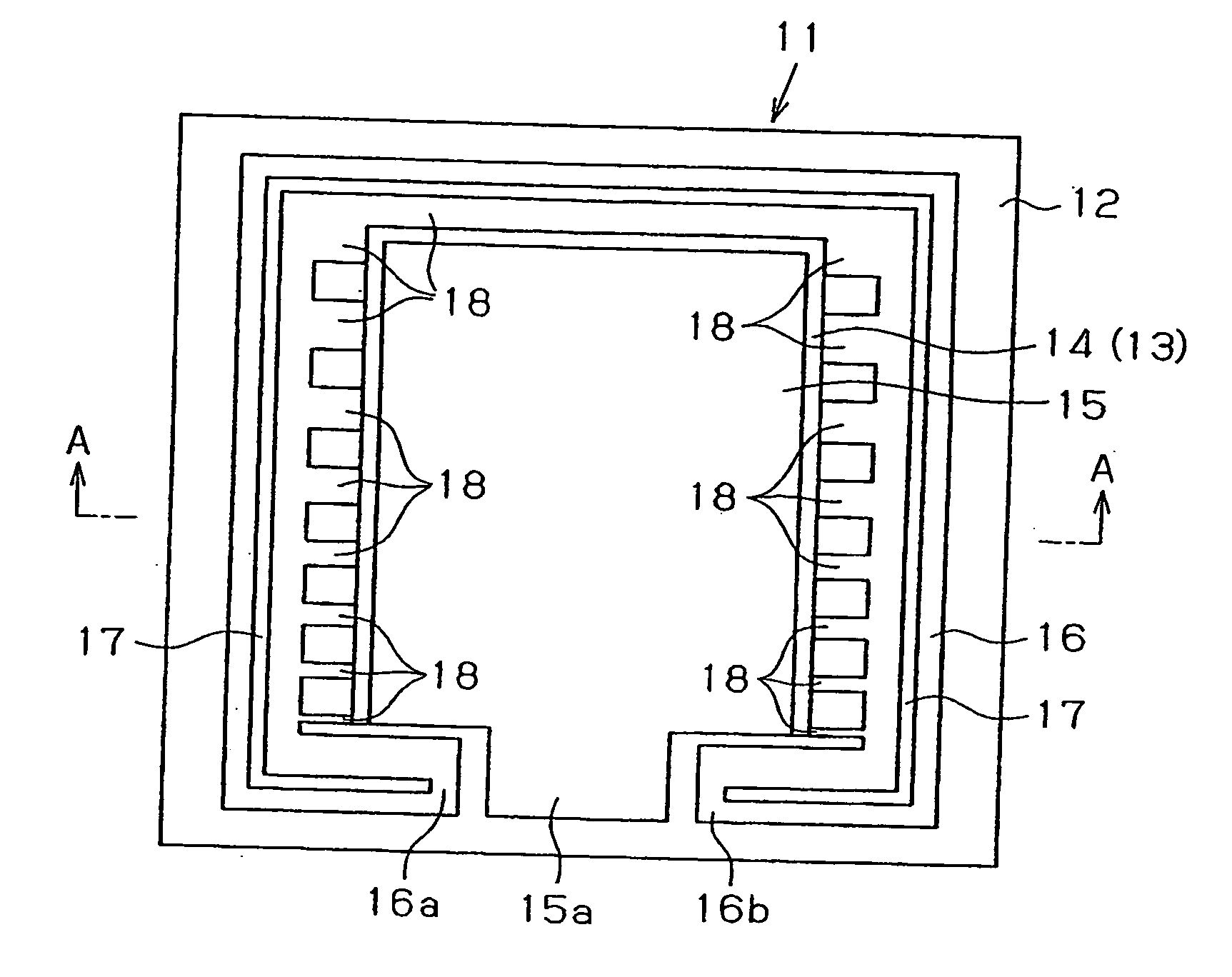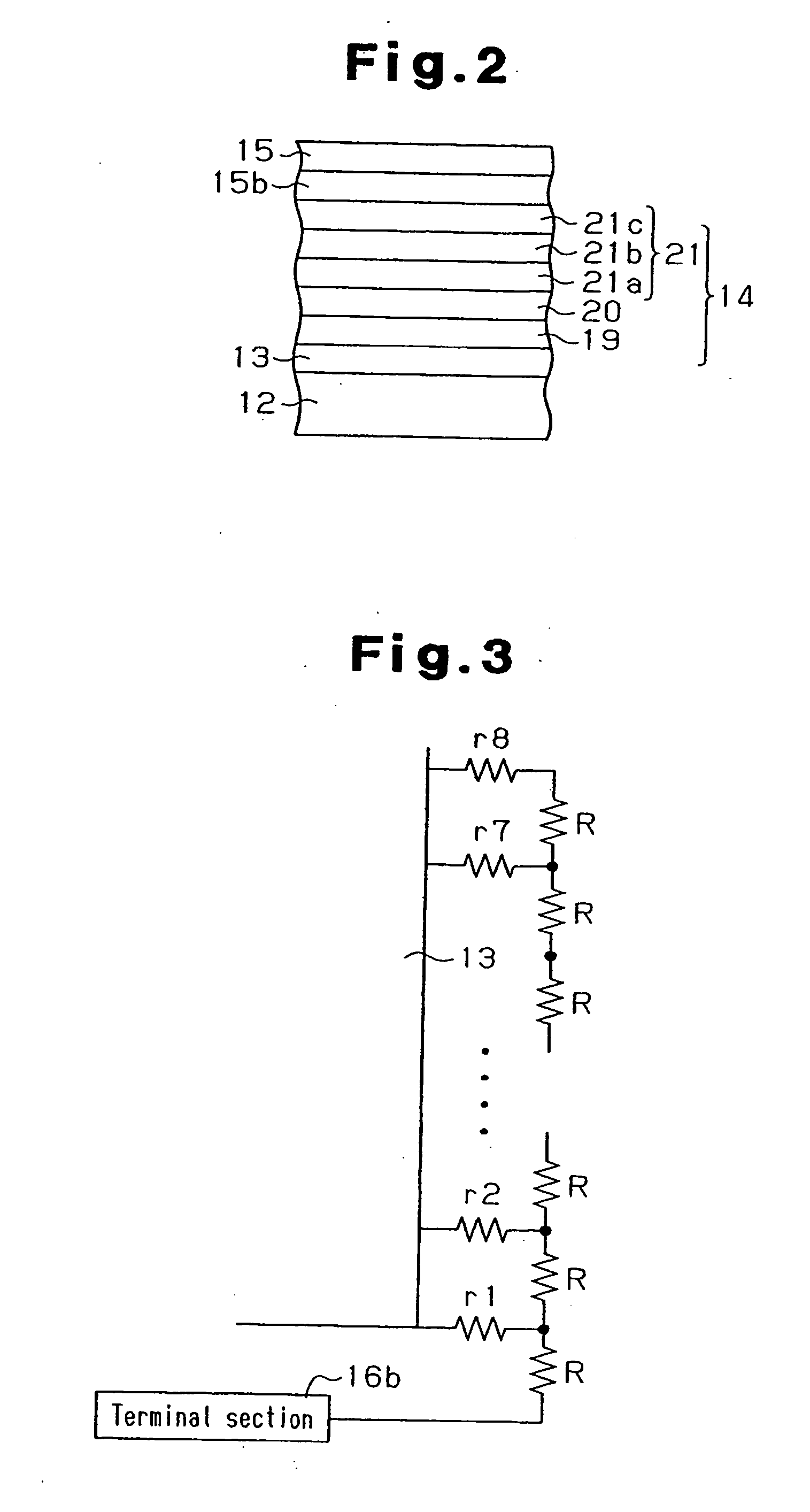Electroluminescence element
a technology of electroluminescent elements and el elements, which is applied in the field of electroluminescent elements, can solve the problems of non-uniform brightness of the light emission zone of the organic el element, relative great difference between the current densities of the corresponding portions of the organic light emission layer, and similar problems in the inorganic field, and achieves higher volume resistivity, lower volume resistivity, and high volume resistivity
- Summary
- Abstract
- Description
- Claims
- Application Information
AI Technical Summary
Benefits of technology
Problems solved by technology
Method used
Image
Examples
first embodiment
[0036] Each of the first electrode 13, the organic light emission layer 14, and the second electrode 15 has a substantially rectangular shape. The organic light emission layer 14 and the first electrode 13 have substantially equal surface areas. The second electrode 15 has a smaller surface area than that of the organic light emission layer 14 for preventing a short circuit between the second electrode 15 and the first electrode 13. In the first embodiment, the first electrode 13 corresponds to an anode and the second electrode 15 corresponds to a cathode. The second electrode 15 has a terminal portion 15a formed in one side of the second electrode 15. The terminal portion 15a connects the second electrode 15 to an external driver circuit (non-illustrated).
[0037] The feeder portion 16 is formed on the substrate 12, extending along the outer circumference of the first electrode 13. The width of the feeder portion 16 is uniform. Two terminal portions 16a, 16b are formed at opposing en...
second embodiment
[0067]FIG. 4 is a plan view showing an organic EL element 22 of the second embodiment from which the organic light emission layer 14 and the second electrode 15 are removed. FIG. 5 is a cross-sectional view showing the structure of the non-light-emission portion of the organic EL element 22, by way of example.
[0068] As shown in FIG. 4, the organic EL element 22 includes a plurality of non-light-emission portions 23. The distribution density of the non-light-emission portions 23 becomes smaller from the outer circumferential portion of the first electrode 13 towards the center. Referring to FIG. 5, the non-light-emission portions 23 are defined by not providing the first electrode 13 at the corresponding portions in the second embodiment. Further, it is preferable that the size of each of the non-light-emission portions 23 be sufficiently small so that the non-light-emission portions 23 are invisible from the exterior of the organic EL element 22.
[0069] The non-light-emission portio...
third embodiment
[0076] As shown in FIGS. 6A and 6B, the organic EL element 24 has a single connector portion 18 that connects the feeder portion 16 to the first electrode 13. The thicknesses of portions of the connector portion 18 corresponding to opposing left and right sides of the first electrode 13 vary continuously. For example, in the third embodiment, the thickness of each of these portions of the connector portion 18 becomes greater as the position farther from the corresponding terminal portion 16a, 16b. Such thickness becomes gradually smaller towards the terminal portion 16a, 16b. Thus, a resistance value per unit length of the connector portion 18 as measured along a direction in which the feeder portion 16 extends becomes lower as the position farther from the terminal portion 16a, 16b. Such value becomes higher as the position closer to the terminal portion 16a, 16b. In other words, the feeder portion 16 extends along one side of the first electrode 13. The resistance value of the con...
PUM
 Login to View More
Login to View More Abstract
Description
Claims
Application Information
 Login to View More
Login to View More - R&D
- Intellectual Property
- Life Sciences
- Materials
- Tech Scout
- Unparalleled Data Quality
- Higher Quality Content
- 60% Fewer Hallucinations
Browse by: Latest US Patents, China's latest patents, Technical Efficacy Thesaurus, Application Domain, Technology Topic, Popular Technical Reports.
© 2025 PatSnap. All rights reserved.Legal|Privacy policy|Modern Slavery Act Transparency Statement|Sitemap|About US| Contact US: help@patsnap.com



